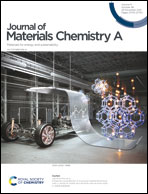Redistributing Zn ion flux by bifunctional graphitic carbon nitride nanosheets for dendrite-free zinc metal anodes†
Abstract
Zinc (Zn) metal with a high chemical stability and low cost has enabled aqueous zinc ion batteries (ZIBs) to show promise for use in large-scale energy storage. However, the unlimited growth of Zn dendrites is the Achilles' heel of ZIBs due to the nonuniform Zn nucleation and deposition. Herein, two-dimensional (2D) graphitic carbon nitride (g-C3N4) nanosheets are employed for the first time to modify glass fibre (GF) separators for highly-stable dendrite-free zinc anodes, in which the g-C3N4 layers act as a bifunctional Zn ion distributor to physically force the diffusion of Zn2+ through the pores of the hybrid separators and chemically guide the Zn2+ ion flux via coordination effects between Zn2+ and the abundant nitrogen species in the g-C3N4 nanosheets. Furthermore, the g-C3N4 layers can efficiently avoid piercing through the hybrid separators and suppress the self-discharging of the ZIBs. As a result, the g-C3N4 nanosheet-modified GF (g-C3N4/GF) separators endow the Zn//Zn symmetrical batteries with a long lifespan of 700 h at 2 mA cm−2 and 2 mA h cm−2, which is superior to the counterpart with g-C3N4-free separators (64 h). In addition, the Zn//MnO2 batteries with g-C3N4/GF separators deliver an enhanced capacity of 280 mA h g−1 at 1C after 400 cycles. Therefore, this work may pave the way to a reliable strategy to design 2D nanosheet-modified separators for high-performance ZIBs.



 Please wait while we load your content...
Please wait while we load your content...